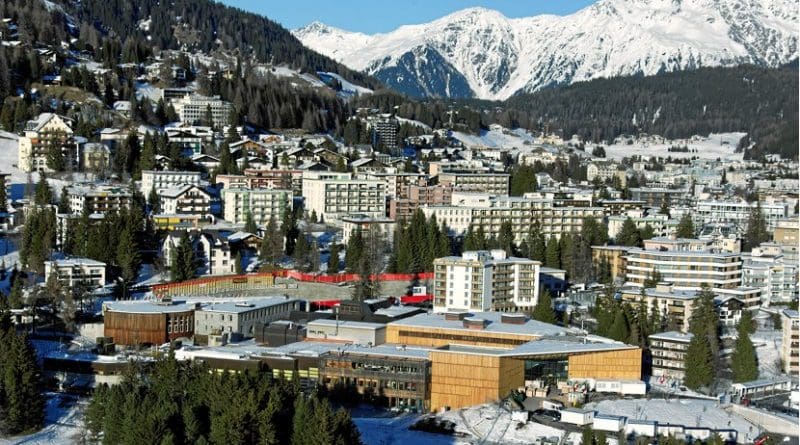World Leaders Aim For Cohesion At Landmark Davos Summit – OpEd
By Arab News
By Andrew Hammond*
The World Economic Forum (WEF) is making final preparations for its landmark 50th anniversary summit at Davos, Switzerland, next week. Yet, while the event is a landmark for international cooperation after a half-century of such sessions, storm clouds are on the horizon, as reflected in this year’s theme of “Stakeholders for a Cohesive and Sustainable World.”
US President Donald Trump, who will be present at the Swiss ski resort, personifies these tensions. It is his “America First” vision that has been a key driver in the breakdown of international agreements and cooperation in the last few years, as it has undermined a range of global agreements, including the Paris climate change treaty.
To be sure, Trump has significant support — in the US and internationally — for his agenda, and he stands a significant chance of winning four more years in office in November. Yet he will not be very popular among the elites and activists in and around Davos, who tend to see him more as a menace than an international messiah.
Others have been more warmly received in Davos, including Xi Jinping, who in 2017 became the first Chinese president to give a speech, in which he made an impassioned defense of globalization in the face of Trump’s protectionist rhetoric.
The key theme of promoting a more cohesive, sustainable world at this year’s Davos underlines that, a generation on from the promise of the late 1980s and early 1990s, which saw the collapse of Soviet communism, many expectations about how the post-Cold War world might look have been dashed, not least around international cooperation. The WEF itself has ridden this wave of optimism and pessimism through its provision in the last several decades of a global platform for dialogue.
Its successes in bolstering international cooperation included the Davos Declaration, signed in 1988 by Greece and Turkey, which saw the two turn back from the brink of war. The following year, North and South Korea held their first ministerial-level meetings at the WEF, while East German Prime Minister Hans Modrow and German Chancellor Helmut Kohl met there to discuss German reunification in 1990.
Three decades on, the idealistic vision of the future held by some of a universal order of liberal, capitalist, democratic states living in peace and contentment has been undermined. As multiple reports highlight, there is currently a potentially toxic cocktail of trade disputes, environmental risks, online threats and geopolitical dangers threatening the fundamental fabric of the global political economy.
To be sure, as a generation ago, the US remains the world’s most powerful country, certainly in a military sense. And it can still project and deploy overwhelming force relative to any probable enemy, as Iran, for instance, is well aware as it considers its options after this month’s assassination of Qassem Soleimani.
Yet there are now multiple challenges confronting the US-led order, helping to drive the international fractures that the WEF will discuss. For instance, following Russia’s annexation of Crimea, US relations with Russia are now more strained than at any time since the Cold War, despite Trump’s professed desire to try and reduce the tensions. And the Israeli-Palestinian peace process has collapsed again, while Washington and Pyongyang remain locked into stalled nuclear diplomacy on the Korean Peninsula.
Moreover, almost two decades after 9/11, Washington is still significantly engaged in Afghanistan and the Middle East. Indeed, the US could become significantly more entrenched in the latter region if tensions with Iran continue to grow in 2020.
On the positive side of the ledger, however, today’s world continues to contain multiple positive opportunities for international cooperation. Take the example of the landmark global climate change deal agreed in Paris in 2015, which represented a welcome fillip to efforts to tackle global warming.
Compared to three decades ago, the rise of China is one of the biggest game changers in global affairs. And, in the week in which Washington and Beijing are expected to sign a first stage trade deal, it is increasingly likely that the future of the international order may well depend on the shape of the China-US bilateral relationship. This could be shaping what is sometimes called a multi-bilateral world, or a network of loosely coordinated bilateral and regional trade deals.
One of the key indicators of whether such a future can be realized will come if the two sides can eventually reach a wider, more ambitious and sustainable phase two deal to settle their economic tensions. If so, this could help catalyze a new multi-bilateral trading order, rather than the potential alternative of the world hurtling toward zero-sum trade relations and ultimately into a full-blown economic war.
While a multi-bilateral trade order would be more complicated and less satisfactory than the status quo, it would be better than a zero-sum world that could otherwise be our collective fate.
- Andrew Hammond is an Associate at LSE IDEAS at the London School of Economics

